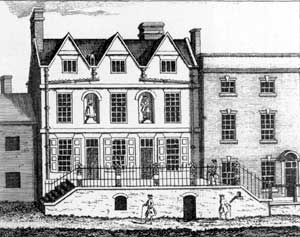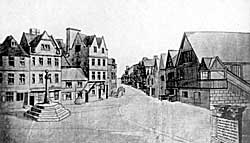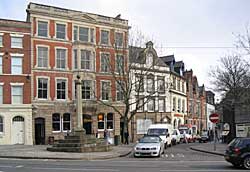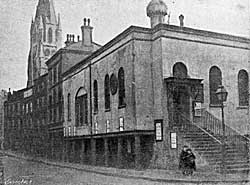< Previous | Contents | Next >
High Pavement, Weekday Cross

Bluecoat School, Weekday Cross, c.1740.
Exactly opposite Garner's Hill stood the old Bluecoat School of Nottingham. The origin of this school is obscure. When some alterations were being made to the building, about 1804, a brass plate was found saying that the school was established in 1706, but the site upon which the original school was built is lost. It appears to have been supported by contributions from the Corporation and others, and it was removed to High Pavement in 1723, and the buildings were erected upon ground given by Mr. William Thorpe, who was a lawyer of Nottingham about that time. The education given in the school appears to have been quite good, with a bias towards religious training which is reflected in the rules which were laid down for the guidance of the trustees in 1793 and which are published in Deering's history. The school was moved to its present site on Mansfield Road in 1853, and all trace of it has vanished from High Pavement, but there is an illustration still extant which shows us its appearance.
There are several curiosities in connection with High Pavement, which it is perhaps well to recall, for example, in 1775 John Collin, a scion of the benevolent house of Collin, died at his house in High Pavement, and he lies buried in St. Nicholas' Church. I have never been able to identify this house, nor can I account for the fact that the iron fanlight above the doorway of No. 14 is wrought into the shape of a W. I have often wondered whether it was the house of Mrs. Weatherall, whose strange opinions and funeral were considered when we considered St. Mary's Church. Then again, four hundred years ago, in 1533, there is a strange character mentioned in the records, behind whom I am sure there may be a story, for in that year Helen Attewell, who was spoken of as "Helen of High Pavement," got herself into trouble for selling ale above the prices of the assize set by Mr. Mayor. I have often wondered whether this grasping lady founded the tavern business which is to-day represented by the County Inn, and of course our friend Tobias must get himself mixed up with this street, although it was of such tremendous respectability, for it was at the Cock Inn upon High Pavement, wherever that may have been, that Tobias first met Coney his evil genius, which meeting we referred to in some detail during our consideration of Narrow Marsh.
 Weekday Cross, c.1740.
Weekday Cross, c.1740.Weekday Cross was the old daily market of Saxon times, and possibly its origin is even earlier than this. At any rate, the pre-Conquest defence of the town takes a curious turn to the south just here, in order to include this area, showing its importance before the days of Edward the Elder. It is an insignificant place nowadays, but there is evidence that it must have been considerably larger in times gone by, for the old thoroughfare which is represented by Byard Lane does not align with Pilcher Gate and Pepper Street, which are its east and west continuations. This movement of the old street seems to indicate that ground had been filched from the public thoroughfare, a process which was going on generally throughout the English towns, gradually narrowing and choking up the streets, but the movement of Byard Lane is so marked that it seems to indicate that there were no buildings upon the other side of the road, proving and pointing to the fact that the block of buildings between Byard Lane and Middle Pavement are of very much later origin.

Weekday Cross in 2004 (A Nicholson, 2004).
We have said that Weekday Cross was the ancient market-place of the Saxon borough, but when Peveril erected his stronghold upon the Castle cliff a new town, occupied largely by his French followers, sprang up around its walls, and so a large and important suburb was founded outside the town. For a variety of reasons, perhaps the chief of which was the animosity between the English and the French inhabiting these separate districts, it was found convenient to establish a mutual market-place where the two nations could meet to transact business, but could be yet kept sufficiently apart to prevent bloodshed, and so the great open space which has come down to us as the Great Market, but which in times past was called the Saturday Market, was chosen for this purpose. Gradually this Saturday Market became of very great importance in the neighbourhood, for to it resorted the whole countryside, and the business transacted in it was very great indeed. However, the Weekday market still continued and was used for the ordinary household shopping and every-day trading. As a matter of fact the Wednesday market which is held in the Market Place, properly, I believe, should occur at Weekday Cross. The access to this daily market from the Leen and from the lower part of the town was obtained by the two steep thoroughfares of Middle Hill and Garner's Hill, leading respectively to the west and the east end of the Market Place. I think that this market-place must have been very early paved, probably with great boulders, for the traffic it had would be very great indeed. A similar area in York is still called "The Pavement," and though I can trace no such name as having been applied to Weekday Cross, I feel tolerably sure that at some time or other it was so called. It was the centre of the civic life of the old town, and it remained such a centre even after the Conquest, for the English and the French boroughs were divided into two separate governments, each with its own officers and its own laws, and so remained until 1713.
 The old Town Hall, shortly before demolition
in 1896.
The old Town Hall, shortly before demolition
in 1896.In its eastern end stood the Old Moot Hall or Town Hall of the ancient borough, in which was transacted the town's business and in which were the town's prisons, quite different, of course, from the prisons under the Shire Hall, at the eastern end of High Pavement. It is quite likely that these prisons are those referred to as existing in King John's time, but about them we know very little indeed. As it was situated upon a promontory or mound it was referred to occasionally as "Mont Hall," and as a matter of fact Fletcher Gate was at one time called "Mont Hall Gate." How far back into the past the old town hall goes it is almost impossible to say. It was re-built in 1744 and was pulled down just before 1900 in order to make way for the alterations of the Railway. Aesthetically considered, it was no great loss, for it was a particularly ugly building standing upon colonnades with its long side parallel to High Pavement, and reached by a flight of steps leading up from Weekday Cross. Under these steps, or their predecessors, was at one time kept a stock of whale-oil, which was used for the illumination of the town, which must have rendered the neighbourhood somewhat unsavoury. It is recorded that upon one occasion a frost occurred of such intensity as to freeze this stock of whale-oil.
Weekday Cross itself stood in the north-west corner of the area, in front of the more modern entrance to the hall. The first actual mention of it occurs in 1549, but a cross probably existed there much earlier. It was pulled down in 1804, and pictures which remain of it show it to have been an ordinary pillar cross upon steps. The arms had disappeared, and it was crowned by a great stone globe. From the steps surrounding it Royal and municipal proclamations were made, and it was really just an ordinary normal market cross.
In Weekday Market Place were various accommodations. One of the several sets of stocks, which were in use in Nottingham, was placed here, and is mentioned in 1541. A bull-ring also was here in 1580, and was taken up in 1691. It was situated at the corner of the modern Fletcher Gate and Weekday Cross, and the site of the old market-well, which was fitted with a pump in 1636, is marked by the pillar-box just at the end of Middle Pavement.
